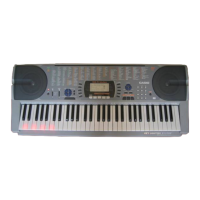
Do you have a question about the Casio CTK-620L and is the answer not in the manual?
| Brand | Casio |
|---|---|
| Model | CTK-620L |
| Category | Electronic Keyboard |
| Language | English |
Explains how the keyboard automatically plays rhythm, bass, and chord parts.
Details the lesson system where keys light up to guide note playing.
Describes the capability to record and play back up to two parts for ensemble play.
Explains using General MIDI tones for computer connectivity and desktop music.
Notes the provision of a terminal for direct connection to a computer for MIDI data.
Warning against modifying the instrument due to risks of fire, shock, or malfunction.
Stipulates risks of death or serious injury if product is operated incorrectly.
Advises to stop use and consult dealer if smoke, odor, or malfunction occurs.
Stipulates risks of injury and physical damage if product is operated incorrectly.
Instructions to take immediate action if the instrument is dropped or damaged.
Precautions for handling the AC adaptor safely, including cord care and voltage use.
Important information and precautions regarding battery installation, use, and disposal.
Information on connecting the keyboard to computers or sequencers via MIDI.
Guidance on loading and replacing batteries, including important precautions.
Details on battery life and symptoms of low battery power, advising timely replacement.
Instructions and warnings for using the specified AC adaptor.
Information on how keyboard settings and memory data are retained or lost.
Step-by-step guide to turning on the keyboard and playing.
Procedure for selecting one of the 137 built-in tones using tone numbers.
Guide to selecting one of the 100 rhythms using rhythm numbers.
How to use the Auto Accompaniment feature with rhythm and chord play.
Procedure for adjusting the volume level of accompaniment parts.
Instructions for selecting a tune from the Song Bank list using tune numbers.
How to adjust the tempo for Song Bank tunes, including preset and manual settings.
Lesson step focusing on timing, allowing any key press to produce the correct note.
Lesson step focusing on melody, guiding correct notes and fingerings.
Lesson step for playing tunes at normal speed, with key lights guiding.
How to edit recorded data by moving the input point and making changes.
Step-by-step procedure for editing data during a step recording operation.
How to delete all recorded data from a specific track.
How to record notes and chords in real-time to Track 1.
How to record chord progressions chord-by-chord into Track 1 using step recording.
Detailed steps for deleting all data from Track 1 or Track 2.
Detailed steps for recording chords to Track 1 using the step recording method.
Instructions for playing back recorded songs from memory.
How to add a melody to Track 2 using real-time recording after recording Track 1.
How to use step recording to input melody notes one-by-one into Track 2.
Detailed steps for inputting melody notes to Track 2 using step recording.
How to layer two different tones (main and layered) to play simultaneously with one key.
Procedure for selecting and layering two different tones on the keyboard.
How to assign different tones to the left and right ends of the keyboard.
How to raise or lower the keyboard's overall key in semitone units.
Procedure for selecting and assigning two different tones to keyboard ends.
Instructions for setting the transpose value to change the keyboard's key.
How to fine-tune the keyboard's pitch to match other musical instruments.
Procedure for adjusting the keyboard's tuning value.
Explains how to connect MIDI devices using MIDI OUT and MIDI IN terminals.
Setting to enable or disable General MIDI mode for external data playback.
How to set the MIDI channel used for sending messages from the keyboard.
Setting the MIDI channel for displaying notes and lighting keys from external data.
Setting to use MIDI IN data for chord specification via the MODE switch.
Setting to determine if keyboard sounds are connected to internal sound source or MIDI OUT.
Troubleshooting steps for when no sound is produced by the keyboard.